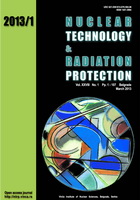
DESIGN AND INSTALLATION OF A HOT WATER LAYER SYSTEM AT THE TEHRAN RESEARCH REACTOR
Pages: 18-24
Authors: Sayedeh Leila Mirmohammadi, Morteza Gharib,
Parnian Ebrahimzadeh, and Reza Amrollahi
Abstract
A hot water layer system (HWLS) is a novel system for reducing radioactivity under research reactor containment. This system is particularly useful in pool-type research reactors or other light water reactors with an open pool surface. The main purpose of a HWLS is to provide more protection for operators and reactor personnel against undesired doses due to the radioactivity of the primary loop. This radioactivity originates mainly from the induced radioactivity contained within the cooling water or probable minute leaks of fuel elements. More importantly, the bothersome radioactivity is progressively proportional to reactor power and, thus, the HWLS is a partial solution for mitigating such problems when power upgrading is planned. Following a series of tests and checks for different parameters, a HWLS has been built and put into operation at the Tehran research reactor in 2009. It underwent a series of comprehensive tests for a period of 6 months. Within this time-frame, it was realized that the HWLS could provide a better protection for reactor personnel against prevailing radiation under containment. The system is especially suitable in cases of abnormality, e. g. the spread of fission products due to fuel failure, because it prevents the mixing of pollutants developed deep in the pool with the upper layer and thus mitigates widespread leakage of radioactivity.
Key words: hot water layer system, Tehran Research Reactor, pool-type reactor, radiation level,
containment
FULL PAPER IN PDF FORMAT (740 KB)
